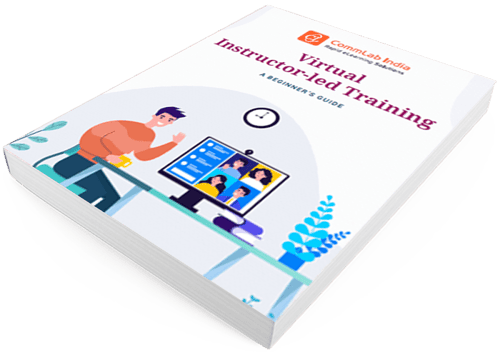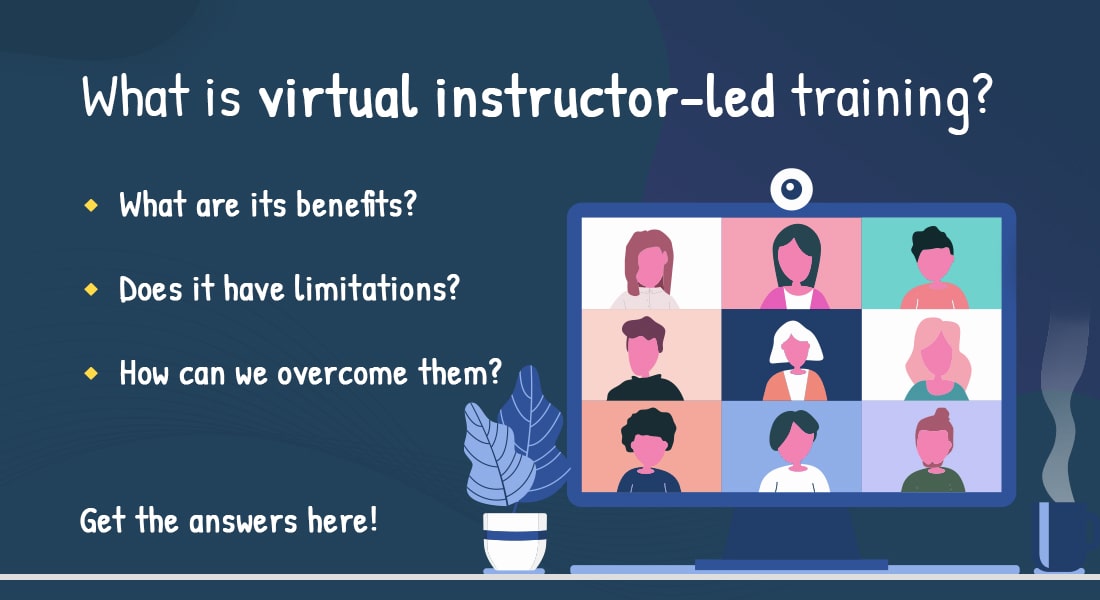A Beginner’s Guide to Virtual Instructor-led Training [eBook]
![A Beginner’s Guide to Virtual Instructor-led Training [eBook] A Beginner’s Guide to Virtual Instructor-led Training [eBook]](https://blog.commlabindia.com/hubfs/Imported_Blog_Media/virtual-instructor-led-training-beginners-guide-ebook.jpg)
Let’s face it. After implementing a hybrid paradigm, your team’s work-life balance may be hurting. In this case, spending several hours on online courses can be inconvenient. As a result, employers have been forced to put their heads together to produce creative ways of teaching their employees across multiple digital platforms. This is why we need virtual instructor-led training (VILT).
What is VILT, and how can it benefit corporate training?
Virtual instructor-led training (VILT) is the closest digital replica of in-person classroom training. These are a few benefits offered by VILT courses:- It allows learners to interact with the instructor in real time.
- It enables learners to reap the benefits of traditional classroom training from the safety and comfort of their own homes.
- It provides easy access to learning for employees in various locations.
What is VILT?
VILT (Virtual instructor-led training) is a highly interactive training style delivered by an instructor via a digital medium. It encourages learning while assuring accessibility, diversity, and adaptability. It also enables learners to reap a majority of the benefits of traditional classroom training from the safety and comfort of their own homes.
Now that we’ve established what VILT involves, let’s look at the types of training solutions we can avail from this compelling approach to training.
Save your spot for the upcoming webinar to know all about classroom to VILT conversion.
What Are the Different Types of Online Training Solutions?
In this situation, firms are increasingly turning to synchronous and asynchronous online training to assure continual learning.
Synchronous online training necessitates the simultaneous attendance of both learners and instructors in the same session, albeit, remotely and from any location. A few examples of synchronous online training are:
- Video Conferences
- VILT
- Webinars
- Lectures broadcasted live
To be clear, recording a live, virtual instructor-led training session and uploading it to your online platform is different from VILT. However, the defining fact is that it is a live, real-time (synchronous) event.
Asynchronous training allows learners to learn more effectively and in their own time without waiting for an instructor. Here are just a few examples:
- eLearning
- Microlearning
- Videos
Due to the coronavirus pandemic VILT has already reached the zenith of its reign in 2020. Let’s now investigate COVID-19’s impact on VILT.
The Impact of COVID-19 On Virtual Instructor-Led Training
The COVID-19 pandemic has put tremendous strain on the IT team as companies try to figure out available technology to help their remote workers perform better and be more productive.
Working remotely, which was previously seen as a win-win, has now become a necessity for companies that want to stay in business. However, the hybrid model comes with its own set of problems some of them being worker isolation, issues with internet bandwidth, a lack of focus on work-related duties, and fear of an uncertain future.
According to a Study, COVID-19 has had a significant impact on workplace training for over 57 % of firms. This is especially true for firms that rely heavily on face-to-face or instructor-led training (ILT).
These organizations were unprepared for the disruption in classroom training that the pandemic brought on. The fall out of the pandemic has been multitudinous and include budgetary restrictions owing to economic uncertainty, a lack of infrastructure, including internet bandwidth and systems, issues of distance learning, and, most crucially, underprepared classroom trainers.
Are you curious to discover the best practises to engage learners in a virtual classroom? How does a virtual classroom differ from a traditional one? You can explore answers to this and more questions by clicking on the link below.
Unveiling the Virtual Instructor-led Training: A Beginner’s Guide eBook!

Providing effective, compelling virtual instructor-led training (VILT) can be stressful because it necessitates adapting classroom content and activities to the virtual environment. If you want to transition from classroom to virtual training, get a hold of this eBook, “Virtual Instructor-led Training: A Beginner’s Guide.” It delves into the complexities of using technology to create online learning events.
It includes advice on how to ensure that content is well-designed and linked to performance-based learning objectives. It also shows you how to assist trainers that are transitioning to VILT.
This eBook also includes tips for creating and deploying effective, gripping virtual classroom sessions. Here are some of the questions it helps to answer:
What makes a virtual classroom different from a webinar or an in-person presentation?
- How is a virtual classroom different from a traditional classroom?
- What role does technology play?
- What are the key components of an excellent online session?
- What are the different types of training materials?
- Name the common aspects of popular technology platforms.
- Suggest a few tips from trainers.
- Outline the best techniques to involve learners in a virtual classroom.
To Wrap Up!
The rise of virtual learning in the workplace necessitates the adoption of cutting-edge solutions. VILT sessions are interactive and help employees advance in their careers to make a difference. Why wait? Take advantage of the benefits afforded by VILT to improve the performance of your business.
If you want to know more about VILT, then check out this eBook that serves as a detailed guide. Download it now!





